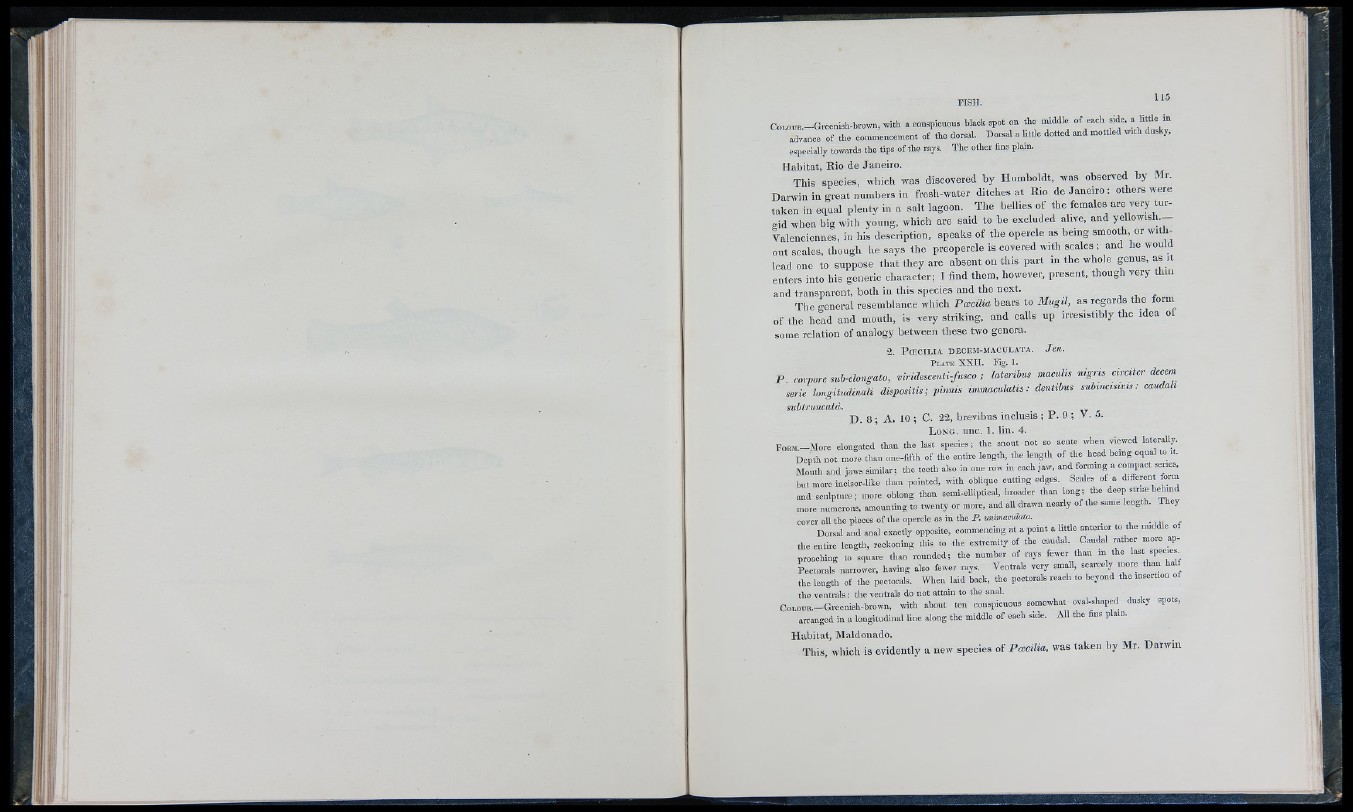
FISH.
CoLOun— G reenisli-brow n, w ith a conspicnoua black spot o n tb e m iddle o f each s.de, a ^
advance o f tho com m encem ent o f the dorsal. D orsal a little d o tted an d m o tü e d w ith dnsky,
especially tow ards tb e tip s o f tb e rays. T h e o th er fins plain.
Habitat, Rio de Janeiro.
This species, which was discovered by Humboldt, was observed by Mr.
D a r w i n i n great numbers in fresh-water ditches at Rio de Janeiro : others were
taken in equal plenty in a salt lagoon. The bellies of the females are very turgid
when big with young, which are said to he e.vcluded alive, and yellow ish.-
Valenciennes, in his description, speaks of the opercle as being smooth, or without
scales, though he says the preopercle is covered with scales ; and he would
lead one to suppose that they are absent on this part in the whole genus, as it
enters into his generic character; I find them, however, present, though very tlun
and transparent, both in this species and the next.
The general resemblance which Paicilia bears to 3Iugil, as regards the form
of the head and mouth, is very striking, and calls up irresistibly the idea o
some relation of analogy between these two genera.
■2. P oe c i l i a d e c e m - m a c u l a t a . Jen.
P l a t e X X I I . F i g . 1 .
P . corpore sul-elongato, viridescenti-fusco ; lateribus maculis nigris circiter decern
serie Iongitudinali dispositis ; pinnis immaculatis: dentibus submcisims : caudali
suhtruncatà. D. 8 ; A. 10 ; C. 22, brevibus inclus•i s ; -Pr>. 9 ; v. 5.
L o n g . u n c . 1. lin . 4 .
r o E M .-iI o r e elongated tbmi the last species; tbe snout not so acute vvhen viewed laterally
D epth not more than one-fifth of the entire length, tbe length of the bead being equal to it.
M outh and jaws similar; the teeth also in one row in each jaw. and forming a compact series,
but more incisor-like than pointed, w ith oblique cutting edges. Scales of a different form
and sculpture; more oblong than semi-elliptical, broader than long; the deep striæ behin
more nnmerons, amounting to twenty or more, and all drawn nearly of the same length. They
c o v c ra lU h e p ie c e s o fth e o p o rc le a sin th e P . ani»MC»lofa. ^
Dorsal and anal e.vactly opposite, eommenoing at a point a little anterior to the middle of
the entire length, reckoning this to the extrem ity of the caud al C audal ratber more approaching
to square than rounded; the num ber of rays fewer than m the 1“=“
Pectorals narrower, having also fewer rays. V entrals very small, scarcely more than half
the length o f the pectorals. W hen laid back, the pectorals reach to beyond the msortion of
the ventrals; the venü-als do not attain to the anal. , , , ,
C o L O O B .-G reonish-brow n, w ith about ten conspicnous somewhat oval-shapcd dusky spots,
arranged in a longitudinal line along the middle of each side. A ll the fins plain.
Habitat, Maldonado.
This, which is evidently a new species of Poecilia, was taken hy Mr. Darwin